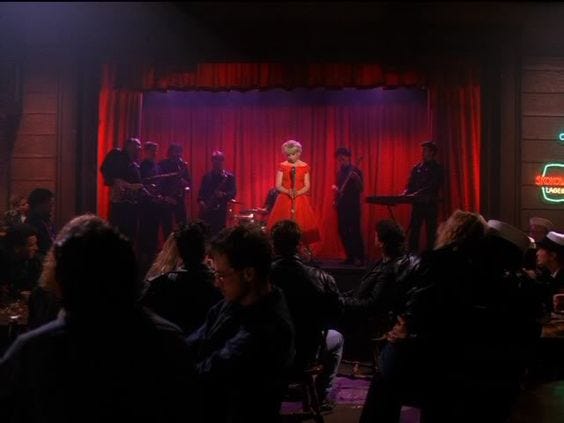Last Wednesday, my friend Grace and I went to a gig at the MOTH Club in Hackney. The band was Faux Real — highly recommend, extremely catchy, great moves, 10/10 costumes, it was probably the best gig I’ve ever been to. But one thing, aside from the performance, that caught both of our attention was the venue itself.
The MOTH Club, which stands for Memorable Order of Tin Hats, is an old military veterans club which now attracts East Londoners like moths to a white-hot flame. Apart from the silver streamers adorning the stage and the glittering wallpaper on the ceiling, its original features have mostly been preserved — the wood panelling, the plaques and framed photos lining the walls, the sign instructing all children to be off the stage by 9:30.
It’s nostalgic, unpretentious, authentic, and combined with the camp little updates it has undergone more recently, it’s completely charming. It reminded me of a drag show at Bethnal Green Working Men’s Club (BGWMC) that I went to with Venetia a couple of years ago where I was equally delighted by the interiors.

While Grace and I sipped our first pints and waited for the music to start, we indulged in some history. According to Wikipedia, Working Men’s Clubs were set up to “provide working-class people with a space to engage with political, educational, and recreational activities”.
Over time, they became pillars of community life and gave members a place to get together affordably, meet friends, host charity events and dances, and, by the sounds of it, play a lot of Bingo.
In the past few decades, membership has sadly and rather unsurprisingly dwindled and these clubs have had to find ways of keeping themselves running. Luckily for us, for many of them, this has meant opening their doors to non-members, with places like BGWMC and MOTH sharing their spaces with “younger, alternative crowds.”
A Huck article on the alternative parties keeping old working-class venues alive tells me that “in a city so often divided by class, race, and age, [working men’s clubs] are providing rare opportunities for generations to come together, supporting fringe events and communities that would also struggle to survive on their own, like live music, comedy, alternative cabaret, and gay and drag nights.”
This unlikely fusion of old and young, traditional and alternative, has cracked open a new life for these places, which could very well have crumbled to the ground without a much-needed jab in the arm. The bingo and the member-only events still happen, but they are kept afloat by a program that pulls a steady flow of young, cool, paying customers through the doors. They give a home to events and people who may not have found a stage for their work without them, and most importantly, they provide an affordable, multi-use space that is accessible to pretty much anyone.
These clubs are classic examples of Third Spaces — a concept that has been doing the rounds lately meaning “social surroundings that are separate from the two usual social environments of home (first) and work (second).” Libraries are Third Spaces. So are community centres, cafés, and — although inaccessible to most — places like Soho House.
Pubs play a huge Third Space role for people in the UK as well, the difference being that once you’ve paid your yearly club membership of around £25, there’s no obligation to drink or spend any money at all. It’s simply a spot for you to come and sit, chat, play darts, and maybe watch a drag queen puppet show.
They are places with long local histories that are moving with the times, making room for groups they may not have 30 years ago, and keeping a vibrant scene alive in the process. If that doesn’t tug on your heartstrings, then just look at them — they’re like a scene straight out of Twin Peaks!
I think the reason I felt compelled to write a whole newsletter about these clubs is because, as I’ve written about before, spaces dedicated to community, that are accessible and affordable and welcoming and fun, are fewer and further between these days, and the more fuss we can make over them, the better.
I’ve recently started working with an urban planning company and have been really heartened to see how many ongoing projects they have with city councils to upgrade or build community centres, but there is something about the grit and the vibe of these Working Men’s Clubs that just hits different. It must have something to do with the glitter and the drag queens and the smell of wood polish and stale beer. For some reason, the whole big jumble is irresistible to me.
See you in the next one,
Annabel x












This looks like such a lovely and authentic specimen of a Third Place! I feel like this sort of thing is much harder to come by here in the states
That’s so cool and British! Lawn Bowling clubs are a bit similar here